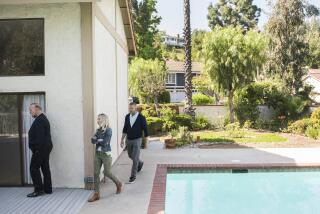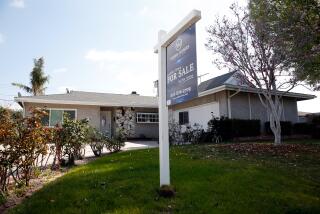New foreclosure cases in California fall sharply in fourth quarter
A new report shows the number of California homes entering foreclosure fell sharply in the fourth quarter as fewer borrowers fell into distress and lenders eased off taking action because of increased scrutiny from regulators.
Actual losses of homes to foreclosure were down as well.
It wasn’t clear how much of the easing resulted from investigations by federal agencies and all 50 states after widespread reports of foreclosure procedural errors and complaints that too few loans were being modified to help borrowers.
A total of 69,799 notices of default, the first step in a foreclosure, were filed at county recorder offices in the Golden State during the fourth quarter, MDA DataQuick Information Systems reported Tuesday.
That was down 16.2% from 83,261 in the third quarter, down 17.5% from 84,568 in the fourth quarter of 2009, and just over half the record 135,431 default notices recorded in the first quarter of 2009.
DataQuick said the riskiest loans, such as those written without verifying high-risk borrowers’ incomes and assets, peaked in 2006. Because many of those loans have already resulted in foreclosures or distress sales, the worst problems with new defaults on subprime loans are behind the industry, although the backlog of distressed loans remains enormous.
In the meantime, the economy has begun a slow recovery so fewer borrowers are losing their jobs.
“We don’t know how much of the decline [in new foreclosures] is due to less household financial distress and how much is due to shifts in lender and servicer foreclosure policies,” DataQuick President John Walsh said. “The level of default activity would certainly be higher if it weren’t for alternative strategies such as short sales or even lengthening grace periods.”
At a mortgage modification fair at the Los Angeles Sports Arena sponsored by the nonprofit Neighborhood Assistance Corp. of America, founder Bruce Marks said lenders are pushing harder to increase the number of modifications. California is a hot spot for the group because of the large number of risky loans made to homeowners.
“You see more of these types of mortgages than in any other part of the country,” Marks said Monday.
DataQuick said that in areas with high home prices, mortgage defaults bucked the general trend and rose slightly quarter over quarter. The 82 California ZIP Codes with median sale prices of $800,000 or more in 2010 logged a 2% increase in default notices from the third quarter.
At the other end of the spectrum, ZIP Codes with 2010 median sales prices of $200,000 or less saw fourth-quarter defaults drop 22.2 % from the third quarter.
As for the big picture in Southern California, Riverside and San Diego counties saw the greatest declines in new foreclosures, down about 25% year over year. They were down 21% in Orange and San Bernardino counties, 15% in Los Angeles County and 11% in Ventura County.
Southern California overall saw 19.71% fewer new foreclosures than a year earlier and 16.6% fewer than in the third quarter.
In the San Francisco Bay Area, new foreclosure filings fell 11.7% compared with the fourth quarter of 2009, reflecting the fact that the pricey area saw much less high-risk lending during the boom years, said DataQuick analyst Andrew LePage.
Most large mortgage servicers halted foreclosure sales in many states during the fourth quarter to review their procedures in response to complaints that homes were being seized despite such errors as “robo-signing” by employees who certified documents they never read.
Trustee deeds recording the loss of California homes to foreclosure totaled 35,431 during the fourth quarter, DataQuick said. That’s down 21.9% from the third quarter and 30.6% from a year earlier. The all-time peak was 79,511 in the third quarter of 2008.
Sean O’Toole, founder of data tracker ForeclosureRadar, said the slowdown was mostly attributable to banks freezing activity during their reviews of foreclosure procedures.
Early indications showed foreclosures moving up a tick as the new year began. O’Toole said notices of default rose 8% in California during the first week of 2011 compared with the first week of 2010.
Times staff writer Alejandro Lazo contributed to this report.
More to Read
Inside the business of entertainment
The Wide Shot brings you news, analysis and insights on everything from streaming wars to production — and what it all means for the future.
You may occasionally receive promotional content from the Los Angeles Times.











